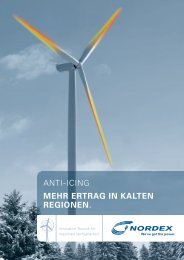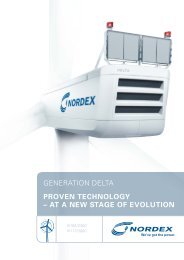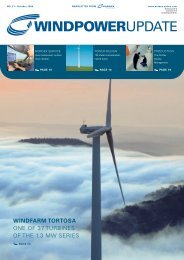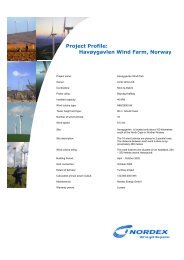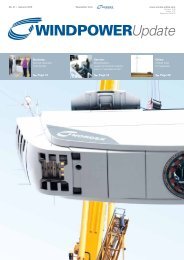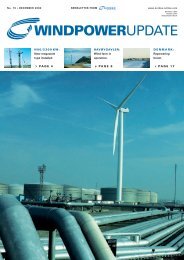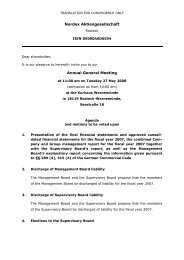OFFERING MEMORANDUM Global Offering of up to ... - Nordex
OFFERING MEMORANDUM Global Offering of up to ... - Nordex
OFFERING MEMORANDUM Global Offering of up to ... - Nordex
You also want an ePaper? Increase the reach of your titles
YUMPU automatically turns print PDFs into web optimized ePapers that Google loves.
which can turn the blade tip ‘‘out <strong>of</strong> the wind’’, acting as a type <strong>of</strong> aerodynamic brake similar <strong>to</strong> the<br />
landing flaps <strong>of</strong> an airplane. The brakes in every wind turbine serve as emergency brakes and —<br />
similarly <strong>to</strong> the hand brake in a car — <strong>to</strong> immobilize and secure the mechanical components.<br />
Pitch regulation<br />
In a wind turbine with pitch regulation, power regulation is achieved by mounting the ro<strong>to</strong>r blades on<br />
the hub so that they can be rotated around their longitudinal axis, in order <strong>to</strong> control their<br />
aerodynamic properties and thus their capacity <strong>to</strong> capture energy according <strong>to</strong> the wind conditions.<br />
When wind speeds (and thus the wind’s energy content) are low, the ro<strong>to</strong>r blades can be turned ‘‘in<strong>to</strong><br />
the wind’’ so that their angle <strong>of</strong> attack is maximized and, when a strong air flow creates <strong>to</strong>o much<br />
energy, they can be turned out <strong>of</strong> the wind. Pitch-regulated wind turbines are braked by allowing the<br />
ro<strong>to</strong>r blades <strong>to</strong> flap like flags in the wind.<br />
In addition, the nominal rotational speed <strong>of</strong> the genera<strong>to</strong>r in wind turbines with pitch regulation can be<br />
adjusted <strong>to</strong> the prevailing wind conditions. These turbines are therefore also described as variablespeed<br />
wind turbines. In these units, an inverter is installed between the genera<strong>to</strong>r and the power grid,<br />
which enables the genera<strong>to</strong>r <strong>to</strong> generate electricity at different frequencies.<br />
The electronic controls in variable-speed wind turbines<br />
In variable-speed wind turbines with pitch regulation, the electronic controls are the ‘‘brain’’ <strong>of</strong> the<br />
turbine and adjust the angle <strong>of</strong> incidence <strong>of</strong> the ro<strong>to</strong>r blades with the genera<strong>to</strong>r <strong>to</strong> keep them working<br />
smoothly <strong>to</strong>gether. A key element <strong>of</strong> the <strong>Nordex</strong> Gro<strong>up</strong>’s expertise is comprised in its electronic<br />
controls. The electronic controls measure the genera<strong>to</strong>r’s power output and, through the pitch<br />
regulation adjust the angle <strong>of</strong> incidence <strong>of</strong> the ro<strong>to</strong>r blades accordingly. If the genera<strong>to</strong>r’s power output<br />
appears <strong>to</strong> be dropping, the ro<strong>to</strong>r blades are turned slightly more in<strong>to</strong> the wind, but if the genera<strong>to</strong>r’s<br />
power output exceeds a pre-defined maximum limit, the electronic controls cause the pitch regulation<br />
system <strong>to</strong> turn the ro<strong>to</strong>r blades out <strong>of</strong> the wind.<br />
The use <strong>of</strong> pitch regulation and the related control options ensures that the wind turbine produces the<br />
maximum possible energy output from the wind in all wind conditions, taking in<strong>to</strong> account not only<br />
variable wind speeds, but also the energy density <strong>of</strong> the wind. The colder the air, i.e. the denser the air<br />
surrounding the wind turbine, the higher the energy density. Consequently, cold wind blowing at the<br />
same speed as a warm wind carries more kinetic energy than the warm wind. In order <strong>to</strong> obtain optimal<br />
energy output, the angle <strong>of</strong> incidence <strong>of</strong> the ro<strong>to</strong>r blades can be adjusted as necessary. The advantages<br />
inherent in this method for the optimization <strong>of</strong> output, in turbines with a capacity <strong>of</strong> approximately 1.5<br />
megawatts or more or in regions with particularly difficult wind conditions, outweigh the substantial<br />
additional costs <strong>of</strong>-pitch regulated systems.<br />
Other wind turbine components<br />
Another component in the development <strong>of</strong> which the <strong>Nordex</strong> Gro<strong>up</strong> has considerable expertise is the<br />
s<strong>up</strong>port system, i.e. the mast <strong>of</strong> the wind turbine. Strong forces act on the mast over the entire life <strong>of</strong><br />
the wind turbine; the nacelle <strong>of</strong> <strong>Nordex</strong>’s largest turbine, the N-80, weighs approximately 84 <strong>to</strong>nnes,<br />
and the ro<strong>to</strong>r weighs approximately 49 <strong>to</strong>nnes. The turbine’s mast has <strong>to</strong> withstand these forces and<br />
provide a secure foundation <strong>to</strong> the nacelle and the ro<strong>to</strong>r without swaying due <strong>to</strong> changes in wind force,<br />
as this would result in the destruction <strong>of</strong> the turbine. The s<strong>up</strong>port systems used by the <strong>Nordex</strong> Gro<strong>up</strong><br />
are manufactured by various outside s<strong>up</strong>pliers <strong>to</strong> the specifications <strong>of</strong> <strong>Nordex</strong> Energy GmbH.<br />
The power generated by the wind turbine, usually at a voltage <strong>of</strong> 700 volts, is converted by a<br />
transformer <strong>to</strong> a ‘‘medium’’ voltage <strong>of</strong> 10 <strong>to</strong> 30,000 volts—depending on the grid opera<strong>to</strong>r—and<br />
s<strong>up</strong>plied in<strong>to</strong> the grid. When several wind turbines are operated <strong>to</strong>gether on a wind farm, the opera<strong>to</strong>r<br />
must ensure that turning on or s<strong>to</strong>pping the wind turbines does not cause electrical surges <strong>to</strong> be fed<br />
in<strong>to</strong> the utility’s power grid, which could cause damage when the electricity reaches power cus<strong>to</strong>mers.<br />
The <strong>Nordex</strong> Gro<strong>up</strong>’s Product Range<br />
The <strong>Nordex</strong> Gro<strong>up</strong>’s product range covers the range <strong>of</strong> wind turbine types currently available on the<br />
market, from the N-29 with 250 kW nominal output <strong>to</strong> the N-80 with 2,500 kW nominal output, which,<br />
46




